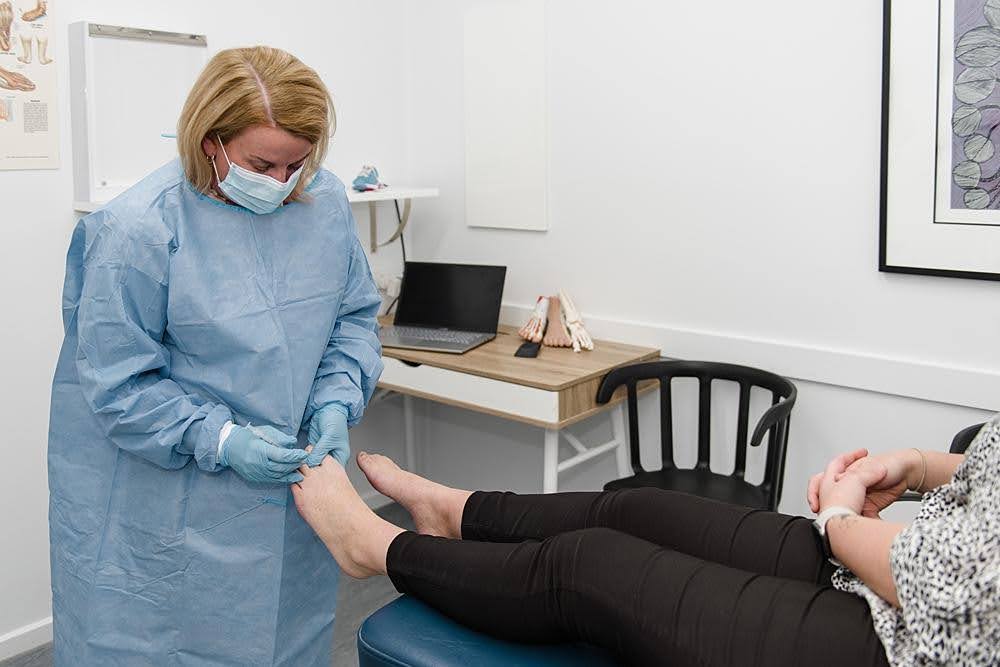Yes, Podiatrists can perform ingrown toenail surgery! Our podiatrist is a highly skilled medical professional who specialises in the diagnosis, treatment, and prevention of conditions related to the feet, including ingrown toenails. They are well-equipped to perform a partial nail avulsion surgery and provide follow-up care. Our podiatrist offers expert treatment for ingrown toenails and can perform ingrown toenail surgery with precision and care.
Understanding Ingrown Toenail Treatment
- The Role of a Podiatrist
- Partial Nail Avulsion Procedure
- Follow-Up Care for Partial Nail Avulsion
Understanding Ingrown Toenails
Ingrown toenails, medically known as onychocryptosis, occur when the edge or corner of a toenail grows into the surrounding skin, causing pain, redness, swelling, and sometimes infection. This condition can affect anyone but is more common in individuals who trim their toenails improperly, wear tight-fitting shoes, or have naturally curved nails.
Ingrown toenails can range from mild discomfort to severe pain and may lead to complications if left untreated. Common symptoms include:
- Pain and tenderness along the nail border
- Redness and swelling around the affected area.
- Formation of pus or drainage
- Infection, which can lead to more serious complications if not addressed.
The Role of a Podiatrist
A podiatrist is a medical professional who specialises in treating conditions related to the feet and ankles. They are highly trained and experienced in diagnosing and managing various foot problems, including ingrown toenails. When you experience an ingrown toenail, it is essential to consult a podiatrist for proper evaluation and treatment.
The role of a podiatrist in addressing ingrown toenails includes:
- Diagnosis: The podiatrist will examine your toe, assess the severity of the ingrown toenail, and determine whether it is infected.
- Treatment Options: The podiatrist will discuss treatment options with you based on the diagnosis. In some cases, conservative measures like warm soaks and antibiotic creams may be sufficient. However, they may recommend a partial nail avulsion procedure if the condition is severe or recurrent.
- Partial Nail Avulsion Procedure
Partial nail avulsion, commonly referred to as nail surgery, is a common and effective procedure used to treat ingrown toenails that do not respond to conservative treatments. Podiatrists typically perform this procedure which involves the removal of a portion of the toenail to address the ingrown edge. Here’s a detailed look at the procedure:
A. Preparation:
- The podiatrist will clean and sterilise the affected area to minimise the risk of infection.
- Local anaesthesia is administered via injection to numb the toe and relieve pain during the procedure.
B. Nail Removal:
- Using specialised instruments, the podiatrist carefully removes the ingrown portion of the toenail.
- This process may involve removing the nail along the entire affected border or just a section, depending on the severity of the ingrown nail.
C. Chemical Cautery:
- To prevent the ingrown nail from regrowing, the podiatrist may apply a chemical solution (usually phenol) to the exposed nail bed. This process, called chemical cautery, destroys the nail matrix, preventing the regrowth of the ingrown nail.
D. Dressing and Bandaging:
- After the procedure, the podiatrist will dress and bandage the toe to promote proper healing and reduce the risk of infection.
- They will provide instructions on caring for the wound and changing the dressing during the recovery period.
E. Follow-Up Care
Follow-Up Care for Partial Nail Avulsion
Proper follow-up care is crucial for a successful recovery after a partial nail avulsion procedure. Your podiatrist will provide you with detailed instructions, but here are some general guidelines:
- Dressing Changes: You must change the toe dressing as directed by your podiatrist. Typically, this should be done daily or as advised.
- Keep it Clean: Keeping the surgical site clean is essential to prevent infection. Wash the area with mild soap and warm water, pat it dry, and apply any prescribed antibiotic ointments or creams.
- Pain Management: You may experience discomfort or mild pain after the procedure. Your podiatrist may recommend over-the-counter pain relievers or prescribe medication to manage pain. Follow their guidance carefully.
- Elevate the Foot: Elevating your foot when resting can help reduce swelling and improve blood circulation to the area. Try to keep your foot elevated whenever possible during the initial recovery period.
- Avoid Tight Footwear: While your toe is healing, avoid wearing tight-fitting shoes or shoes that put pressure on the surgical site. Opt for open-toed or comfortable shoes that provide ample space.
- Limit Physical Activity: For a brief period after the procedure, it’s advisable to limit strenuous physical activity that may put stress on the toe. Your podiatrist will provide recommendations based on your individual case.
- Monitor for Infection: Keep an eye out for signs of infection, such as increased redness, swelling, pus, or worsening pain. If you notice any of these symptoms, contact your podiatrist promptly.
- Follow-Up Appointments: Attend all scheduled follow-up appointments with your podiatrist. These appointments are essential for monitoring the healing process and ensuring that any issues are addressed promptly.
- Nail Regrowth: As the toenail begins to grow back, it’s essential to maintain proper nail care. Trim your nails straight across to prevent future ingrown toenails.
Conclusion
In summary, your podiatrist can perform a partial nail avulsion procedure to treat ingrown toenails effectively. They are crucial in diagnosing, treating, and providing follow-up care for this common foot condition. Following their guidance and adhering to proper post-operative care, you can expect a successful recovery and relief from the discomfort caused by ingrown toenails. If you suspect you have an ingrown toenail, don’t hesitate to seek professional help from your podiatrist to address the issue promptly and prevent potential complications.

